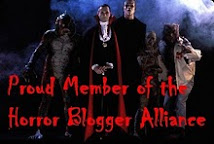I open with all of that because I wanted to make myself aware of it as I sat down to revisit The Howling this week. As much as I want to compare The Howling to movies I like more, there's really not a lot of reason to compare what is actually on screen to anything else made in the '80s. Dante's film, co-written by the brilliant John Sayles, pushes the boundaries of werewolf legends and manages to create a new and modern tribute to The Wolf Man without sacrificing its place as a serious horror film. All of those films I mentioned earlier offer their horror with a heavy dose of comedy, but The Howling maintains a straight face in almost every scene.
Dee Wallace stars as a television reporter who gets too deep in an investigation of a killer and finds herself face to face with a madman who doesn't seem entirely human. She is unharmed, but the trauma of the event leads her psychiatrist (named after Wolf Man director George Waggner and played by the fantastic Patrick Macnee) to recommend some time away at a secluded colony down the coast. This colony isn't exactly calming, and Wallace finds herself surrounded by odd and devious characters and deeper in legends about good old fashioned werewolves.
Dante is more well known for making his films playful about their darkness, and the biggest difference between The Howling and what we expect from the director is that the dark side of his story gets preferential treatment this time out. There are some humorous moments and a few macabre and ironic events, but The Howling is first and foremost a cruel horror film. The best example of this comes in the form of Eddie Quist, the antagonist played by a nearly unrecognizable Robert Picardo. In what might be the film's best sequence, a nosy friend of the lead, played by Belinda Balaski, is pursued by a creature that reveals itself to be Eddie and transforms before her eyes. Picardo is a Dante favorite who has been primarily used in comedic or light hearted roles, but his performance as Quist is unhinged and devilish. Sayles and co-writer Terence Winkless give him a couple of gems in the one-liner department as well - after being called crazy he snarls "Oh, I'm much more than that!", for example - which helps Eddie stand out as a neat new twist on the werewolf legend.
Picardo isn't the only shining star in the supporting cast, as the inhabitants of the colony make up one of the more memorable horror clans this side of The Texas Chain Saw Massacre. Elisabeth Brooks is the visual standout as Eddie's sister who seems to be in heat, while classic names like Slim Pickens and John Carradine add a little bit of fun to the community. Perhaps the biggest treat of the film is another Dante regular, Dick Miller, reprising his "Walter Paisley" character name as the owner of a book store who happens to know as much about werewolves as his books tell him. It's a neat little twist to have Miller filling in the pseudo-Van Helsing role, and his few scenes help establish the film's balance between modern horror cynicism and classic horror reverence.
Near the end of the film, Carradine's elder member of The Howling's community proclaims "You can't tame what's meant to be wild...it just ain't natural" and does a pretty great job of summing up what this movie does for the werewolf subgenre. Wallace is a perfect foil to this big bad wolf tale, and her ability to emote from opening scene to her big finale reiterates that this sect of werewolves is wild and dangerous. Horror movies that are more tame can work and work well, but there's something pretty great about The Howling's willingness to be wild and primal as it offers it's tribute to werewolves of the past.
















4 comments:
I love this movie although I also prefer An American Werewolf in London, but I still remember a preview for The Howling on my VHS of Predator... it was pretty creepy.
I want to bugger Dee Wallace (as the bird was in 1966 when the bird was 18, not as the bird is now obviously).
I want to bugger Belinda Balaski (as the bird was in 1965 when the bird was 18, not as the bird is now obviously).
I want to bugger Elisabeth Brooks (as the bird was in 1969 when the bird was 18, not as the bird is now obviously, which is dead, unfortunately).
Post a Comment